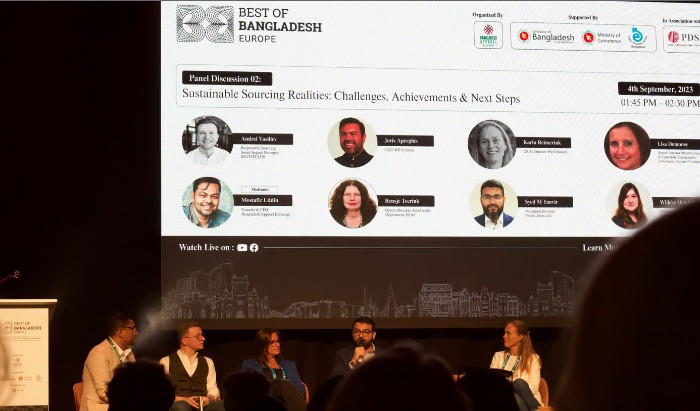Best of Bangladesh (BoB) recently held in the Gashouder Westergas in Amsterdam – focuses on innovative and sustainable practices from the garment and textile sector.
Organized by the Bangladesh Apparel Exchange (BAE), with support from the Embassy of Bangladesh, Commerce Ministry, Export Promotion Bureau of Bangladesh and in association with PDS on 04 and 05 September – looked to transform the image of the key manufacturing industries of Bangladesh and to stage a country with a thriving economy and massive potential.

A representative from the International Apparel Federation (IAF) said to media, “Bangladesh is now putting on its own event. I think that statement is strong.”
Campaign Coordinator at SKC, Christie Miedema said to media, “A lot has changed in the factories falling under the International Accord in terms of safety since 2013.”
Best of Bangladesh provided a true and comprehensive depiction of progress in Bangladeshi apparel production. With a clear message to address the systemic challenges of the clothing industry, governments, brands, suppliers, and unions must continue to collaborate.
For instance, a renowned denim manufacturer in the country, Denim Expert highlighted of an in-house recycling facility that allows 30% (pre-consumer) blending.
“It is slightly more expensive, but many of our customers still choose this option – including the big mass-produced brands,” they said to media.
While Hasan Rahat of Pacific Jeans – one of the leading denim manufacturer with a production of 120 thousand pairs per day – said to media that brands like Inditex and H&M sometimes drop out due to the price disparity.
Mohammad Monirozzaman of Jamuna Denims Weaving said positively about Jeanologia’s innovative Ozone, Eflow, and Laser machines, which assist the denim supplier in saving water and energy.
While on the second-panel session of the Best of Bangladesh, “Sustainable Sourcing Realities: Challenges, Achievements & Next Steps,” sheds light on the challenges, triumphs, and future prospects of ethical sourcing. Distinguished speakers engaged in a dynamic discourse, revealing insights into how Bangladesh has been shaping the landscape of fostering a responsible ecosystem.
Bangladesh is the world’s second-biggest exporter of readymade garments (RMG). Almost 80% of the country’s total annual export earnings come from the RMG industry – in which Europe plays a big role. With a volume of 1.33 billion kilograms of RMG sent to the EU last year, Bangladesh surpassed China (1.31 billion kilograms), the previous number one.
Bangladesh’s economic growth has everything to do with its favorable trade position. Bangladesh is one of the ‘Least Developed Countries’ (LDC), but it will leave that status behind in 2026.
Rensje Teerink, European Union Deputy Director EEAS Asia-Pacific said, “Currently, the Everything but Arms (EBA) rule allows the country to export anything but arms to Europe without tariffs and quotas. No country has benefited as much as Bangladesh: at least 60% of all merchandise entering Europe under EBA comes from Bangladesh and that is mostly textiles.
“If they ‘graduate’ to a developing country, they are no longer allowed to participate in EBA and those will be lost. After a three-year phase-out period, they then have to join the Generalised Scheme of Preferences Plus (GSP+) which will also make it harder for them to export. We still need to see the exact rights they will receive because that legislation is not yet finalized, but the conditions are stricter, especially in the area of human rights,” Rensje Teerink added.
EU delegates highlighted that to continue getting support from the EU under GSP+, Bangladesh must also obey to regulations.
Bangladesh – the second-largest apparel exporter to the EU after China – exported $22.89 billion worth of apparel to the EU market in 2022, showcasing a remarkable 35.69% year-on-year growth. And over the last 5 years, the value of the EU’s RMG imports from Bangladesh has demonstrated a Compound Annual Growth Rate (CAGR) of 9.42%. This growth overtook the EU’s average annual apparel imports growth rate of 4.31% from the rest of the world.
Between 2015 and 2020, European brands ordered 14% more annually from Bangladeshi apparel suppliers. The major buyer was Germany with 7.28 billion in orders in 2022, followed by Spain (3.27), France (2.74), Italy (2.01), Poland (1.83), and the Netherlands (1.7).
The event was flooded with experts from diverse sectors to hail five decades of trade between Europe and Bangladesh.
















